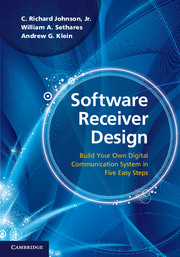1 - A Digital Radio
from Step 1 - The Big Picture
Published online by Cambridge University Press: 05 June 2012
Summary
What Is a Digital Radio?
The fundamental principles of telecommunications have remained much the same since Shannon's time. What has changed, and is continuing to change, is how those principles are deployed in technology. One of the major ongoing changes is the shift from hardware to software–and Software Receiver Design reflects this trend by focusing on the design of a digital software-defined radio that you will implement in Matlab.
“Radio” does not literally mean the AM/FM radio in your car; it represents any through-the-air transmission such as television, cell phone, or wireless computer data, though many of the same ideas are also relevant to wired systems such as modems, cable TV, and telephones. “Software-defined” means that key elements of the radio are implemented in software. Taking a “software-defined” approach mirrors the trend in modern receiver design in which more and more of the system is designed and built in reconfigurable software, rather than in fixed hardware. The fundamental concepts behind the transmission are introduced, demonstrated, and (we hope) understood through simulation. For example, when talking about how to translate the frequency of a signal, the procedures are presented mathematically in equations, pictorially in block diagrams, and then concretely as short Matlab programs.
Our educational philosophy is that it is better to learn by doing: to motivate study with experiments, to reinforce mathematics with simulated examples, to integrate concepts by “playing” with the pieces of the system.
- Type
- Chapter
- Information
- Software Receiver DesignBuild your Own Digital Communication System in Five Easy Steps, pp. 2 - 14Publisher: Cambridge University PressPrint publication year: 2011



